
The afternoon session on the second day of the 2016 Global Dressage Forum exemplified that strong horse talent and good riding will secure the Olympic future of dressage, probably alongside a slightly braver judging as discussed in the morning. The 2016 Global Dressage Forum sought ways to tackle a more progressive path for the discipline and handled the problem well with the discsussion on media promotion and sponsorship of dressage competitions on the first day.
The second day of the Forum clearly had a red line running through its program: talented horses and a good education of the riders are essential for future high performance success. In Germany the national equestrian federation has set up an outstanding system to educate young riders to become riding and teaching professionals.
The education of a German Professional Rider ("Berufsreiter") goes via a three year school program run by the German Equestrian Federation and recognized and certified, though not financially supported, by the German government. Markus Scharmann, who is responsible for the educational system at the German NF and President of the Equestrian Educational Network, explained that the Berufsreiter vocational education is meant to "set up an environment to give young people the experience to educate and train horses on their path to a professional career."
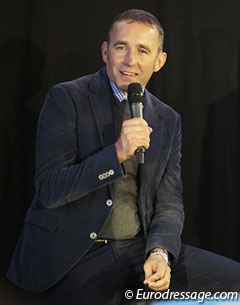 The education for Bereiter runs for 3 years with a minimum of 2 years working at a recognized equestrian centre (approx 600 stables in Germany, including Hof Kasselmann). Thirty percent of their time is spent in school, 70% in the stable. After that a Bereiter Masters degree is available, which means an additional two to four years in which the rider has to prove s/he can train a horse from one level to the other, as well as set up a training concept for their stable with horses. Examiners will check their progress every 12 months to see if the goals are met. The Masters programme works with a short module system so they can keep their job, while getting educated.
The education for Bereiter runs for 3 years with a minimum of 2 years working at a recognized equestrian centre (approx 600 stables in Germany, including Hof Kasselmann). Thirty percent of their time is spent in school, 70% in the stable. After that a Bereiter Masters degree is available, which means an additional two to four years in which the rider has to prove s/he can train a horse from one level to the other, as well as set up a training concept for their stable with horses. Examiners will check their progress every 12 months to see if the goals are met. The Masters programme works with a short module system so they can keep their job, while getting educated.
"We call it the Learn & Earn system," said Scharmann. The newly graduated bereiters "have a good chance of getting a job in their education stable, in a new stable or their own family yard. Students have to keep a diary which the master signs each day. There is a learning plan and it is checked with in-between tests and the final examination. The stable pays for the monthly fee. It's learn by working."
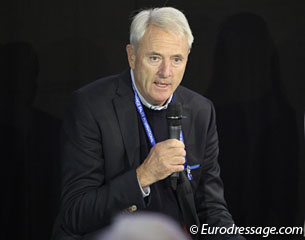 Dorothee Schneider, Hubertus Schmidt and Johnny Hilberath all got their Bereiter degree and the German federation bestowds the title of "Reitmeister' (riding master) on those who have achieved great success. Jean Bemelmans is an example of a reitmeister, as well as Ingrid Klimke. Bemelmans reminisced: "I was not so good at school. I was 16 years and I wanted to make my life, not just a career. My father told me to find a good riding school." Because his knowledge of German was limited at the time, Jean began working in a jumping yard first. "That's when I got my first bit of luck. You need to meet the right people at the right time. There I was told to be a dressage rider because my eye was not so good for jumping," he joked. "Then I met Mr Schmidtke and that was the luck of my life," said Jean about his first big sponsor who supported him onwards to his international dressage career.
Dorothee Schneider, Hubertus Schmidt and Johnny Hilberath all got their Bereiter degree and the German federation bestowds the title of "Reitmeister' (riding master) on those who have achieved great success. Jean Bemelmans is an example of a reitmeister, as well as Ingrid Klimke. Bemelmans reminisced: "I was not so good at school. I was 16 years and I wanted to make my life, not just a career. My father told me to find a good riding school." Because his knowledge of German was limited at the time, Jean began working in a jumping yard first. "That's when I got my first bit of luck. You need to meet the right people at the right time. There I was told to be a dressage rider because my eye was not so good for jumping," he joked. "Then I met Mr Schmidtke and that was the luck of my life," said Jean about his first big sponsor who supported him onwards to his international dressage career.
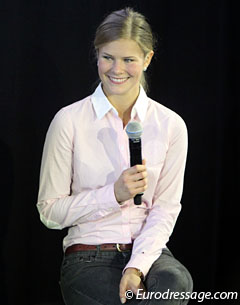 Two young girls, Sina Aringer and Anna Jung, were asked to speak about their experience getting the Bereiter degree and how it has given them both the opportunity to work and get experience at famous barns. Aringer just completed her degree at Hof Kasselmann, while Jung would be doing her exams one week after the forum. She worked at Andreas Dibowski's place.
Two young girls, Sina Aringer and Anna Jung, were asked to speak about their experience getting the Bereiter degree and how it has given them both the opportunity to work and get experience at famous barns. Aringer just completed her degree at Hof Kasselmann, while Jung would be doing her exams one week after the forum. She worked at Andreas Dibowski's place.
When Bemelmans was asked where he sees the future to attract young people to save the quality of riding in horse sport, the Belgian born trainer replied, "the passion is the most important thing at the end of the day. People get more and more spare time, which they can fill up with sport. Nowadays there is more of a partnership between the student and trainer going on. It's a question of respecting each other. I, as a trainer, want to be part of this changing process as times change."
Good Riding Means a Good Warm Up
The entire afternoon program was a string of high quality presentations of top schooling of young horses up to established Grand Prix horses, including the world's number 1.
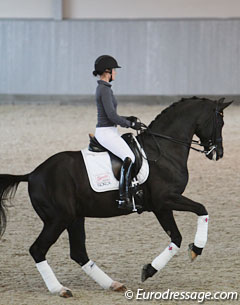 German team trainer Monica Theodorescu and Olympian Kristina Bröring-Sprehe demonstrated how they envisage a good warm-up and how they maintain a horse's fitness. They brought along the best example for that, Desperados, who had had a show break after winning team gold and kur bronze at the 2016 Olympic Games. Monica saw the 15-year old Hanoverian licensed stallion again for the first time since Rio.
German team trainer Monica Theodorescu and Olympian Kristina Bröring-Sprehe demonstrated how they envisage a good warm-up and how they maintain a horse's fitness. They brought along the best example for that, Desperados, who had had a show break after winning team gold and kur bronze at the 2016 Olympic Games. Monica saw the 15-year old Hanoverian licensed stallion again for the first time since Rio.
Desparados looked fresh and fit but it was obvious that the new surrounding distracted him a bit, as he regularly peeped left and right while Kristina was slowly warming him up. "He is like always very fresh and powerful on the first day at a new competition. He behaves like a stallion. He's very macho, a strong stallion but sensitive. He's like a bull," said Monica. "Kristina needs to get some energy out without losing all that energy, just so he's controlable, rideable with enough energy for him to do his best in on the last day (of a show)."
Sprehe's warm-up strategy is corners and transitions, half halts, quarter halts to get the hindlegs under and to get him to accept the aids. "He can be a bit nasty on the leg, in the flying changes where you can hardly touch him," Monica explained. "We do basic exercises: circles, half circles, change direction. He feels stronger on the left so you tend to be stronger on the left, but you have to do the gymnastics on both hands. Both reins need to be the same. Kristina can never get aggressive. He's really smart, he never forgets anything."
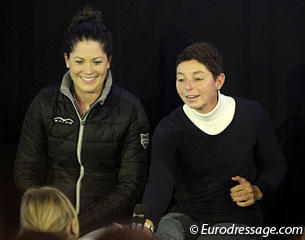 Theodorescu was very open to reveal how they handle the breeding stallion's behaviour at show grounds. "When there is a mare, especially a chestnut mare, Kristina is not there. He also gets aggressive at other stallions, for instance when Jessica (von Bredow) warms up her black stallion (Unee BB). They both put their ears back." Sprehe always takes her stallion a full day in advance to the show, otherwise he can get too strong to handle. "
Theodorescu was very open to reveal how they handle the breeding stallion's behaviour at show grounds. "When there is a mare, especially a chestnut mare, Kristina is not there. He also gets aggressive at other stallions, for instance when Jessica (von Bredow) warms up her black stallion (Unee BB). They both put their ears back." Sprehe always takes her stallion a full day in advance to the show, otherwise he can get too strong to handle. "
To maintain Desperados' top level it is not about practising the Grand Prix movements. "It's all about suppleness now," said Monica. "Most of the time she works him in a snaffle. At shows in the morning he also gets out in a sniffle. He likes the cheapest, plastic snaffle. He can be strong, but it's not about the curb and pulling him down. It's about him being relaxed and accepting the aids. We don't ask the piaffe on the spot very often. We often make turns in the half steps. With the extended trot there is no need to practice the full diagonal, he always wants to go. Maybe once at the show to get the feeling. We always work on the basics."
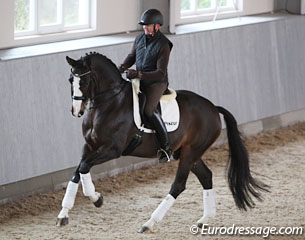 A-squad rider Hubertus Schmidt brought the Danish warmblood gelding Hedelunds Mefisto (by Michellino) to the Forum for his demonstration of a warm up and what we saw was a very traditional build-up: posting trot in a forward-downward stretching position, riding corners and circles, shoulder in, some traversal movements. The dark bay Mefisto, which has been secured for Schmidt by a sponsor a few months ago, definitely brought a dose of Michellino to the Forum and was very tense and distracted, but Schmidt clearly took his time to have the horse properly relaxed. The 20-minute demonstration was not about riding Grand Prix, but about a Grand Prix rider dealing with a Grand Prix level trained horse that was tense. It was all about the basics.
A-squad rider Hubertus Schmidt brought the Danish warmblood gelding Hedelunds Mefisto (by Michellino) to the Forum for his demonstration of a warm up and what we saw was a very traditional build-up: posting trot in a forward-downward stretching position, riding corners and circles, shoulder in, some traversal movements. The dark bay Mefisto, which has been secured for Schmidt by a sponsor a few months ago, definitely brought a dose of Michellino to the Forum and was very tense and distracted, but Schmidt clearly took his time to have the horse properly relaxed. The 20-minute demonstration was not about riding Grand Prix, but about a Grand Prix rider dealing with a Grand Prix level trained horse that was tense. It was all about the basics.
"Good Grand Prix horses are a little hot and quite sensitive," Schmidt said at the start. "I do posting trot and first I work on the right flexion and bending and work on the natural crookedness, so I ride a lot of circles. I stretch the neck forwards and downwards with contact, steady with both reins. This horse is tense so first I need to relax him before I do any collection. I have to relax his body and mind. At home I do a few minutes posting trot, but now it takes longer than I thought," he confessed. "Hot horses tend to run. Whether you ride a 5-year old or a Grand Prix horse, the first 10 minutes are exactly the same." As soon as Mefisto started to relax a bit, Schmidt was able to ride some shoulder-in, half passes and canter work towards the pirouettes. "The shoulder-in is to prepare the half pass and the half pass in canter is the perfect preparation for the pirouette. The inside rein connects to the inside hind leg, so in pirouettes my inside rein has to be soft so the hindleg can reach under."
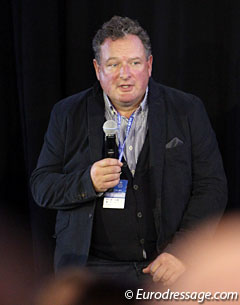 In a small panel discussion after those demonstrations, German team vet Dr. Marc Koene joined Schmidt, Sprehe and Theodorescu. He touched upon a very important point, which nowadays seems ignored by many riders, even those at the highest levels: the cool down. Many of them ride their test and as soon as they have left the arena, they just have their horse walked to the barn, instead of properly cooling it down with some final stretching over the back and a good breather in walk. Dr. Koene could have replied more in depth on the importance of the cool down but instead just stated: "the cool down is a very important phase. Eventers do a one-hour cool down, but that is an explosive sport. Dressage doesn't need that."
In a small panel discussion after those demonstrations, German team vet Dr. Marc Koene joined Schmidt, Sprehe and Theodorescu. He touched upon a very important point, which nowadays seems ignored by many riders, even those at the highest levels: the cool down. Many of them ride their test and as soon as they have left the arena, they just have their horse walked to the barn, instead of properly cooling it down with some final stretching over the back and a good breather in walk. Dr. Koene could have replied more in depth on the importance of the cool down but instead just stated: "the cool down is a very important phase. Eventers do a one-hour cool down, but that is an explosive sport. Dressage doesn't need that."
When Monica was asked what the most common mistake made in the warm-up is, she replied "many inexperienced riders work too much or too long before the test. After the test they say, I could have done five minutes less. Don't start your work at the show warm up. Be prepared, so you have a secure feeling when you come to the show ground. Every horse is different and after the test you always know more than before." Hubertus Schmidt added, "inexperienced riders ride more and more spectacular piaffe-passage in the warm up until it gets to a point where it become bad."
Spotting and Training Young Horse Talent
At the 2004 Global Dressage Forum at Bartels' Academy in The Netherlands, Hof Kasselmann gave a demonstration of their training methods for young dressage horses. For the 2016 edition, they reproduced a similar exhibition but with a clear focus on the work in-hand and first half steps for young dressage horses.
Andreas Senge and Johannes Augustin showed how they handle youngsters in hand and how they teach them baby half steps to spot a horse's talent for piaffe. Ullrich Kasselmann explained that "in the early 1980s I had a talk with Georg Theodorescu on how to check if young horse has talent for piaffe-passage. He helped us and after him Franz Kukuk did and now we have Andreas and Johannes."
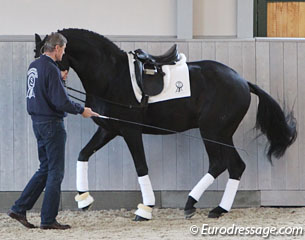 The two handlers brought in 2016 PSI auction horses Dr Sambuco (by Dr Jackson x Samba Hit) and Revenant (by Rock Forever x Sir Donnerhall). Augustin explained that they teach the half steps in hand without the weight of the rider on. They apply normal fixed side reins so there is direct contact with the bit, but they are set fairly long, so the horse always has a chance to go forward or get away when it gets scared. They work in hand with normal reins, instead of a lunge line ("it's too much stuff in my hands"). They first walk the horse in the open part of the arena so it doesn't feel scared or closed up, instead of setting it up against the wall straight away. First the whip is just put on the hindquarters to check for a reaction. "The horse needs to concentrate on the trainer and learn to listen to the trainer," he added. "They always go forward and we put them in a shoulder in. The trainer needs to be calm and quiet."
The two handlers brought in 2016 PSI auction horses Dr Sambuco (by Dr Jackson x Samba Hit) and Revenant (by Rock Forever x Sir Donnerhall). Augustin explained that they teach the half steps in hand without the weight of the rider on. They apply normal fixed side reins so there is direct contact with the bit, but they are set fairly long, so the horse always has a chance to go forward or get away when it gets scared. They work in hand with normal reins, instead of a lunge line ("it's too much stuff in my hands"). They first walk the horse in the open part of the arena so it doesn't feel scared or closed up, instead of setting it up against the wall straight away. First the whip is just put on the hindquarters to check for a reaction. "The horse needs to concentrate on the trainer and learn to listen to the trainer," he added. "They always go forward and we put them in a shoulder in. The trainer needs to be calm and quiet."
Augustin handled the black Revenant himself and the horse showed incredible talent for piaffe, with good sit in the half steps. "He waits for me the whole time. He stands still, does the rein back. When they do it by themselves on the ground, you can give the horse to the rider and he'll do it, even on voice command. This horse has talent for it; a strong back, good neck. If he kicks out, it doesn't matter, he reacts."
Kasselmann added that his young horses are trained in hand once a week. They are warmed up first and then go in hand, all of them. "Not all have the same talent of course," he said. "We start the 3-year olds and then for half a year they go back in the field. Then the 4-year olds go two months on the canter track to build muscles. The youngsters still go in the field. I even close the barn, they have to go outside no matter what the weather." When asked how Augustin deals with the not so talented horse, he replied. "Talent is one thing. Every horse can learn half steps. Important is that you don't get frustrated. Just don't break it. Give them time," he said. "Sometimes some are ridden more first. Adapt the in-hand work on how the horse is developing."
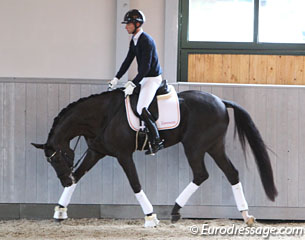 Jean Bemelmans stepped into the arena with his student Borja Carrascosa on Joanne Vaughan's 6-year old Dilestrio (by Delamanga x Monteverdi). The huge black gelding was acquired by Vaughan at the PSI auction but first got some rest because he was growing so much. "We decided to go slowly with him. His muscles and tendons were not ready for more work. You can go step by step with talented horses and experienced riders, even though the horse is not ready yet," said Bemelmans. "At the moment he is trained once or twice a week and for the rest he is walked." Spanish WEG team rider Borja Carrascosa began riding Dilestrio extremely long and low with a very light rein and in posting trot. "He is open but there is connection between the hind leg, rider and mouth. If you don't have contact in front, you are lost. In too light a contact it is more difficult. If you can put the nose in any position you want, it shows you have body control, said Jean. "We didn't train lateral movements because he grew so much. You have to be careful. A top Grand Prix horse can be 18, so he still has 12 years. There is no reason to go fast and destroy him."
Jean Bemelmans stepped into the arena with his student Borja Carrascosa on Joanne Vaughan's 6-year old Dilestrio (by Delamanga x Monteverdi). The huge black gelding was acquired by Vaughan at the PSI auction but first got some rest because he was growing so much. "We decided to go slowly with him. His muscles and tendons were not ready for more work. You can go step by step with talented horses and experienced riders, even though the horse is not ready yet," said Bemelmans. "At the moment he is trained once or twice a week and for the rest he is walked." Spanish WEG team rider Borja Carrascosa began riding Dilestrio extremely long and low with a very light rein and in posting trot. "He is open but there is connection between the hind leg, rider and mouth. If you don't have contact in front, you are lost. In too light a contact it is more difficult. If you can put the nose in any position you want, it shows you have body control, said Jean. "We didn't train lateral movements because he grew so much. You have to be careful. A top Grand Prix horse can be 18, so he still has 12 years. There is no reason to go fast and destroy him."
Bemelmans and Carrascosa demonstrated that you can easily teach a young horse some technique. "Better early than all of a sudden arrive at that level and start from nothing," said Bemelmans. Dilestrio has a massively ground covering walk and when a spectator asked if he could collect it, Borja demonstrated that Dilestrio can keep a clear 4-beat rhythm in collection, even though he gets a bit slow. "I never see a 10 for collected walk, but piaffes and extended trots get 10. Why never the collected walk when it is more difficult sometimes," Bemelmans wondered out loud. Jean spoke with quite a fun, playful tone during his session and at the end of it he asked Augustin to come back into the arena and see if Dilestrio still remembered the in-hand work Johannes did with him two years ago. The lanky gelding easily executed the half steps with Johannes just standing next to him.
 The next pair to enter the arena was Nicole Wego on the 9-year old Australian bred Hanoverian SPH Dante (by Welfenadel x Dormello), owned by Elena and Sergej Knyaginichev and coached by Hartmut Lammers. "It's important the horse has fun. In my opinion, rhythm goes before bending," said Lammers. "We do only 10 meters of passage steps and then forward again to get the energy back. If you passage too long at this age, they loose the regularity because they don't have the strength yet." Augustin also demonstrated how piaffe work in-hand works beneficial when the rider is on top. The horse piaffed with Augustin just standing there. "He has the talent to close behind and keep the rhythm," said Johannes.
The next pair to enter the arena was Nicole Wego on the 9-year old Australian bred Hanoverian SPH Dante (by Welfenadel x Dormello), owned by Elena and Sergej Knyaginichev and coached by Hartmut Lammers. "It's important the horse has fun. In my opinion, rhythm goes before bending," said Lammers. "We do only 10 meters of passage steps and then forward again to get the energy back. If you passage too long at this age, they loose the regularity because they don't have the strength yet." Augustin also demonstrated how piaffe work in-hand works beneficial when the rider is on top. The horse piaffed with Augustin just standing there. "He has the talent to close behind and keep the rhythm," said Johannes.
Enter Johnny Hilberath with his student Dorothee Schneider on Professor Heicke's 8-year old Hanoverian gelding Faustus (by Falsterbo x Forest xx). The dark bay gelding was previously owned and competed by Dirk Linden and arrived at Dorothee's half a year ago. Faustus is Dorothee's new rising Grand Prix horse and hope for the future. The long-legged gelding showed himself to be a phenomenal mover and made hearts of the hardcore dressage aficionados flutter. Schneider spoke from the saddle and explained that her philsophy for training is based on two concepts. First, "the horse has to have a good mental state to begin the work." Her horses daily get 1 to 2 hours in the sand paddock or the field and youngsters are ridden four times per week and lunged once, as well as occasionnly do a few small jumps. According to Schneider, a good mental state is also maintained by a rider with a good seat "so that the horse has a good balance." Secondly it's the training itself.
 While riding Faustus, Dorothee emphasized a few points. She rides a lot of transitions from canter to trot and back to canter, "to feel the horse in front of me. He has to be light and soft in the mouth. He is a big mover and for the shoulder in I do inside leg - outside rein. The flexion on the left is easier, on the right side I have to work on improving the bending," she admitted. "I test and prove the balance in canter by riding the zig zag on the long side on the second track. "This horse sometimes comes behind my hip, so I have to drive him to my hand. That's the daily target: to have him more in front of my hip, so he can take more weight and have more power for the more difficult exercises." Coach Hilberath added that riding gifted horses often makes riders overambitious and too eager to ask for the spectacular too soon: "don't ride on the talent of the horse. Be careful of what you take from what the horse offers you."
While riding Faustus, Dorothee emphasized a few points. She rides a lot of transitions from canter to trot and back to canter, "to feel the horse in front of me. He has to be light and soft in the mouth. He is a big mover and for the shoulder in I do inside leg - outside rein. The flexion on the left is easier, on the right side I have to work on improving the bending," she admitted. "I test and prove the balance in canter by riding the zig zag on the long side on the second track. "This horse sometimes comes behind my hip, so I have to drive him to my hand. That's the daily target: to have him more in front of my hip, so he can take more weight and have more power for the more difficult exercises." Coach Hilberath added that riding gifted horses often makes riders overambitious and too eager to ask for the spectacular too soon: "don't ride on the talent of the horse. Be careful of what you take from what the horse offers you."
The Forum finale came with Isabell Werth presenting her newest addition, the 4-year old Hanoverian mare Superb (by Surprice x Donautanz) which her sponsor Madeleine Winter-Schulze bought at the 2015 Verden Elite Auction for 250,000 euro. "When I test a horse at the auction, the change to buy it goes down. Then I test more horses to confuse them, or I don't test it. I saw her rideability and we bought her unridden. I sat on her afterwards and I called Madeleine to tell her we didn't make a mistake," Werth reminisced. The Olympian calls the mare "Super B" instead of "superb".
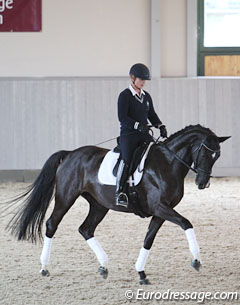 The 2016 Global Dressage Forum presented Germany's top Grand Prix riders with their young horses, developing Grand Prix horses and confirmed international stars, but the riding styles were significantly different. While Hubertus Schmidt showed old-school classical riding with the careful warm up of posting trot, circles and corners and then methodically ask for more, classically trained riders like Kristina Bröring-Sprehe and Dorothee Schneider also exhibited the necessary dose of talent and feeling on their horses presented. Isabell Werth, Germany's most successful dressage rider to date, has a very different style on her young horses: fun, playful and definitely cowboy-like with her long reins, hands wide apart and constantly clicking voice. While there is certainly system in Werth's 'madness', one can immediately see where she going at and what the future in four years will be: a highly talented Grand Prix horse with the same silhouette all her horses have. It proved that there are definitely different ways leading to Rome!
The 2016 Global Dressage Forum presented Germany's top Grand Prix riders with their young horses, developing Grand Prix horses and confirmed international stars, but the riding styles were significantly different. While Hubertus Schmidt showed old-school classical riding with the careful warm up of posting trot, circles and corners and then methodically ask for more, classically trained riders like Kristina Bröring-Sprehe and Dorothee Schneider also exhibited the necessary dose of talent and feeling on their horses presented. Isabell Werth, Germany's most successful dressage rider to date, has a very different style on her young horses: fun, playful and definitely cowboy-like with her long reins, hands wide apart and constantly clicking voice. While there is certainly system in Werth's 'madness', one can immediately see where she going at and what the future in four years will be: a highly talented Grand Prix horse with the same silhouette all her horses have. It proved that there are definitely different ways leading to Rome!
In twenty minutes Werth had gymnasticized Superb, also on circles and with transitions, but she regularly asked her mare to make quick steps behind, she shortened and lengthened the strides, threw in a wild flying change, asked for a quick reaction and got a buck instead and all this while giving the horse a good feeling and patting her reassuringly numerous of times. While the reins were long, the contact was always light and respectful. "I look for a connection between the right and the left rein. Superb is always in a super rhythm, very sensitive and when they react to just a touch, I love that. In walk she's overstepping and looking for my connection," said Werth. "I try not to sit too heavy to make it not too difficult for her. I sit like a show jumper. I play with the flying changes. I teach them before the counter canter. It makes no sense to avoid it. In the field they do it themselves."
 Werth embodied how she is playing with the ability of the horse and her communication with the horse. She showed lots of canter-walk transitions, while the voice aids were continuously resounding through the speaker system. "I normally work her 15 to 20 minutes, 3 to 4 times a week. "I need to modulate the body of the horse to increase and improve the talent," Werth stated. "It's my passion to ride the young horses myself and not just take over when they are 6, 7 or 8. Horse breeding has improved so much the past twenty years. We now have such light and willing horses."
Werth embodied how she is playing with the ability of the horse and her communication with the horse. She showed lots of canter-walk transitions, while the voice aids were continuously resounding through the speaker system. "I normally work her 15 to 20 minutes, 3 to 4 times a week. "I need to modulate the body of the horse to increase and improve the talent," Werth stated. "It's my passion to ride the young horses myself and not just take over when they are 6, 7 or 8. Horse breeding has improved so much the past twenty years. We now have such light and willing horses."
Dutch trainer Henk van Bergen made a very striking concluding speech at the end of the day in which he asked the judges not to undervalue the importance of self carriage. "I was afraid self carriage was disappearing. All I saw in competition were big movements, tight necks and horses strong in the hand. As long as the movement was there, all was fine," Van Bergen boldly and correctly stated. "I am glad to see self-carriage is here on the highest level. I ask for particular attention for that from the judges. I have seen it here!"
Text by Astrid Appels - Photos © Astrid Appels / Ruchel
Related Links
2016 Global Dressage Forum - Day Two: Judges Hold the Olympic Future of Dressage
2016 Global Dressage Forum - Day One: Double Lunge Work and Youth Talent Takes Centre Stage
2016 Global Dressage Forum - Day One: Surprise FEI Revelations, Media and Sponsorship